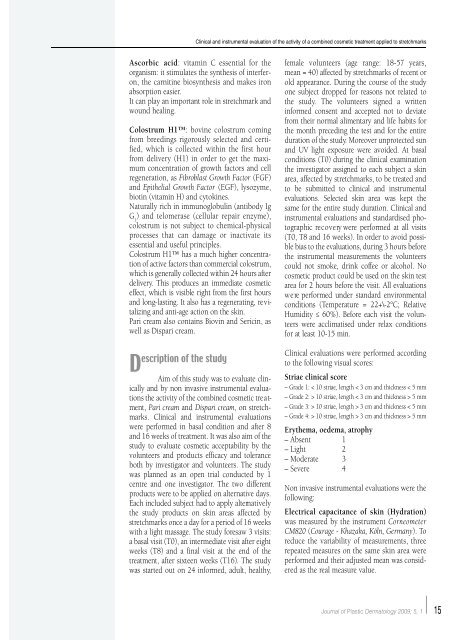Vol. 5, n. 1, January-March 2009 1th International ... - Salute per tutti
Vol. 5, n. 1, January-March 2009 1th International ... - Salute per tutti
Vol. 5, n. 1, January-March 2009 1th International ... - Salute per tutti
You also want an ePaper? Increase the reach of your titles
YUMPU automatically turns print PDFs into web optimized ePapers that Google loves.
Clinical and instrumental evaluation of the activity of a combined cosmetic treatment applied to stretchmarks<br />
Ascorbic acid: vitamin C essential for the<br />
organism: it stimulates the synthesis of interferon,<br />
the carnitine biosynthesis and makes iron<br />
absorption easier.<br />
It can play an important role in stretchmark and<br />
wound healing.<br />
Colostrum H1: bovine colostrum coming<br />
from breedings rigorously selected and certified,<br />
which is collected within the first hour<br />
from delivery (H1) in order to get the maximum<br />
concentration of growth factors and cell<br />
regeneration, as Fibroblast Growth Factor (FGF)<br />
and Epithelial Growth Factor (EGF), lysozyme,<br />
biotin (vitamin H) and cytokines.<br />
Naturally rich in immunoglobulin (antibody Ig<br />
G 1 ) and telomerase (cellular repair enzyme),<br />
colostrum is not subject to chemical-physical<br />
processes that can damage or inactivate its<br />
essential and useful principles.<br />
Colostrum H1 has a much higher concentration<br />
of active factors than commercial colostrum,<br />
which is generally collected within 24 hours after<br />
d e l i v e ry. This produces an immediate cosmetic<br />
e ffect, which is visible right from the first hours<br />
and long-lasting. It also has a regenerating, re v italizing<br />
and anti-age action on the skin.<br />
Pari cream also contains Biovin and Sericin, as<br />
well as Dispari cream.<br />
escription of the study<br />
D<br />
Aim of this study was to evaluate clinically<br />
and by non invasive instrumental evaluations<br />
the activity of the combined cosmetic tre a tment,<br />
Pari cre a m and Dispari cre a m, on stre t c hmarks.<br />
Clinical and instrumental evaluations<br />
w e re <strong>per</strong>formed in basal condition and after 8<br />
and 16 weeks of treatment. It was also aim of the<br />
study to evaluate cosmetic acceptability by the<br />
volunteers and products efficacy and tolerance<br />
both by investigator and volunteers. The study<br />
was planned as an open trial conducted by 1<br />
c e n t re and one investigator. The two diff e re n t<br />
p roducts were to be applied on alternative days.<br />
Each included subject had to apply altern a t i v e l y<br />
the study products on skin areas affected by<br />
s t retchmarks once a day for a <strong>per</strong>iod of 16 weeks<br />
with a light massage. The study foresaw 3 visits:<br />
a basal visit (T0), an intermediate visit after eight<br />
weeks (T8) and a final visit at the end of the<br />
t reatment, after sixteen weeks (T16). The study<br />
was started out on 24 informed, adult, healthy,<br />
female volunteers (age range: 18-57 years,<br />
m e a n = 40) affected by stretchmarks of recent or<br />
old appearance. During the course of the study<br />
one subject dropped for reasons not related to<br />
the study. The volunteers signed a written<br />
informed consent and accepted not to deviate<br />
f rom their normal alimentary and life habits for<br />
the month preceding the test and for the entire<br />
duration of the study. Moreover unprotected sun<br />
and UV light exposure were avoided. At basal<br />
conditions (T0) during the clinical examination<br />
the investigator assigned to each subject a skin<br />
a rea, affected by stretchmarks, to be treated and<br />
to be submitted to clinical and instrumental<br />
evaluations. Selected skin area was kept the<br />
same for the entire study duration. Clinical and<br />
instrumental evaluations and standardised photographic<br />
re c o v e ry were <strong>per</strong>formed at all visits<br />
(T0, T8 and 16 weeks). In order to avoid possible<br />
bias to the evaluations, during 3 hours before<br />
the instrumental measurements the volunteers<br />
could not smoke, drink coffee or alcohol. No<br />
cosmetic product could be used on the skin test<br />
a rea for 2 hours before the visit. All evaluations<br />
w e re <strong>per</strong>formed under standard enviro n m e n t a l<br />
conditions (Te m p e r a t u re = 22+\-2°C; Relative<br />
Humidity ≤ 60%). Before each visit the volunteers<br />
were acclimatised under relax conditions<br />
for at least 10-15 min.<br />
Clinical evaluations were <strong>per</strong>formed according<br />
to the following visual scores:<br />
Striae clinical score<br />
– Grade 1: < 10 striae, length < 3 cm and thickness < 5 mm<br />
– Grade 2: > 10 striae, length < 3 cm and thickness > 5 mm<br />
– Grade 3: > 10 striae, length > 3 cm and thickness < 5 mm<br />
– Grade 4: > 10 striae, length > 3 cm and thickness > 5 mm<br />
Erythema, oedema, atrophy<br />
– Absent 1<br />
– Light 2<br />
– Moderate 3<br />
– Severe 4<br />
Non invasive instrumental evaluations were the<br />
following:<br />
Electrical capacitance of skin (Hydration)<br />
was measured by the instrument Corneometer<br />
CM820 (Courage - Khazaka, Köln, Germany). To<br />
reduce the variability of measurements, three<br />
repeated measures on the same skin area were<br />
<strong>per</strong>formed and their adjusted mean was considered<br />
as the real measure value.<br />
Journal of Plastic Dermatology <strong>2009</strong>; 5, 1<br />
15

















